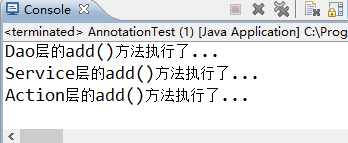在 Spring 中,尽管使用 XML 配置文件可以实现 Bean 的装配工作,但如果应用中 Bean 的数量较多,会导致 XML 配置文件过于臃肿,从而给维护和升级带来一定的困难。 Java 从 JDK 5.0 以后,提供了 Annotation(注解)功能,Spring 也提供了对 Annotation 技术的全面支持。Spring3 中定义了一系列的 Annotation(注解),常用的注解如下。 1)@Component 可以使用此注解描述 Spring 中的 Bean,但它是一个泛化的概念,仅仅表示一个组件(Bean),并且可以作用在任何层次。使用时只需将该注解标注在相应类上即可。 2)@Repository 用于将数据访问层(DAO层)的类标识为 Spring 中的 Bean,其功能与 @Component 相同。 3)@Service 通常作用在业务层(Service 层),用于将业务层的类标识为 Spring 中的 Bean,其功能与 @Component 相同。 4)@Controller 通常作用在控制层(如 Struts2 的 Action),用于将控制层的类标识为 Spring 中的 Bean,其功能与 @Component 相同。 5)@Autowired 用于对 Bean 的属性变量、属性的 Set 方法及构造函数进行标注,配合对应的注解处理器完成 Bean 的自动配置工作。默认按照 Bean 的类型进行装配。 6)@Resource 其作用与 Autowired 一样。其区别在于 @Autowired 默认按照 Bean 类型装配,而 @Resource 默认按照 Bean 实例名称进行装配。 @Resource 中有两个重要属性:name 和 type。 Spring 将 name 属性解析为 Bean 实例名称,type 属性解析为 Bean 实例类型。如果指定 name 属性,则按实例名称进行装配;如果指定 type 属性,则按 Bean 类型进行装配。 如果都不指定,则先按 Bean 实例名称装配,如果不能匹配,则再按照 Bean 类型进行装配;如果都无法匹配,则抛出 NoSuchBeanDefinitionException 异常。 7)@Qualifier 与 @Autowired 注解配合使用,会将默认的按 Bean 类型装配修改为按 Bean 的实例名称装配,Bean 的实例名称由 @Qualifier 注解的参数指定。
1. 创建 DAO 层接口 在 src 目录下创建一个名为 com.mengma.annotation 的包,在该包下创建一个名为 PersonDao 的接口,并添加一个 add() 方法,如下所示。 package com.mengma.annotation; public interface PersonDao { public void add(); } 2. 创建 DAO 层接口的实现类 在 com.mengma.annotation 包下创建 PersonDao 接口的实现类 PersonDaoImpl,编辑后如下所示。 package com.mengma.annotation; import org.springframework.stereotype.Repository; @Repository("personDao") public class PersonDaoImpl implements PersonDao { @Override public void add() { System.out.println("Dao层的add()方法执行了..."); } } 上述代码中,首先使用 @Repository 注解将 PersonDaoImpl 类标识为 Spring 中的 Bean,其写法相当于配置文件中 <bean id="personDao"class="com.mengma.annotation.PersonDaoImpl"/> 的书写。然后在 add() 方法中输出一句话,用于验证是否成功调用了该方法。
3. 创建 Service 层接口 在 com.mengma.annotation 包下创建一个名为 PersonService 的接口,并添加一个 add() 方法,如下所示。 package com.mengma.annotation; public interface PersonService { public void add(); } 4. 创建 Service 层接口的实现类 在 com.mengma.annotation 包下创建 PersonService 接口的实现类 PersonServiceImpl,编辑后如下所示。 package com.mengma.annotation; import javax.annotation.Resource; import org.springframework.stereotype.Service; @Service("personService") public class PersonServiceImpl implements PersonService { @Resource(name = "personDao") private PersonDao personDao; public PersonDao getPersonDao() { return personDao; } @Override public void add() { personDao.add();// 调用personDao中的add()方法 System.out.println("Service层的add()方法执行了..."); } } 上述代码中,首先使用 @Service 注解将 PersonServiceImpl 类标识为 Spring 中的 Bean,其写法相当于配置文件中 <bean id="personService"class="com.mengma.annotation.PersonServiceImpl"/> 的书写。 然后使用 @Resource 注解标注在属性 personDao 上(也可标注在 personDao 的 setPersonDao() 方法上),这相当于配置文件中 <property name="personDao"ref="personDao"/> 的写法。最后在该类的 add() 方法中调用 personDao 中的 add() 方法,并输出一句话。
5. 创建 Action 在 com.mengma.annotation 包下创建一个名为 PersonAction 的类,编辑后如下所示。 package com.mengma.annotation; import javax.annotation.Resource; import org.springframework.stereotype.Controller; @Controller("personAction") public class PersonAction { @Resource(name = "personService") private PersonService personService; public PersonService getPersonService() { return personService; } public void add() { personService.add(); // 调用personService中的add()方法 System.out.println("Action层的add()方法执行了..."); } } 上述代码中,首先使用 @Controller 注解标注 PersonAction 类,其写法相当于在配置文件中编写 <bean id="personAction"class="com.mengma.annotation.PersonAction"/>。 然后使用了 @Resource 注解标注在 personService 上,这相当于在配置文件内编写 <property name="personService"ref="personService"/>。 最后在其 add() 方法中调用了 personService 中的 add() 方法,并输出一句话。
6. 创建 Spring 配置文件 在 com.mengma.annotation 包下创建一个名为 applicationContext.xml 的配置文件,如下所示。 <?xml version="1.0" encoding="UTF-8"?> <beans xmlns="http://www.springframework.org/schema/beans" xmlns:xsi="http://www.w3.org/2001/XMLSchema-instance" xmlns:aop="http://www.springframework.org/schema/aop" xmlns:p="http://www.springframework.org/schema/p" xmlns:tx="http://www.springframework.org/schema/tx" xmlns:context="http://www.springframework.org/schema/context" xsi:schemaLocation=" http://www.springframework.org/schema/beans http://www.springframework.org/schema/beans/spring-beans-2.5.xsd http://www.springframework.org/schema/aop http://www.springframework.org/schema/aop/spring-aop-2.5.xsd http://www.springframework.org/schema/tx http://www.springframework.org/schema/tx/spring-tx-2.5.xsd http://www.springframework.org/schema/context http://www.springframework.org/schema/context/spring-context.xsd"> <!--使用context命名空间,通知spring扫描指定目录,进行注解的解析--> <context:component-scan base-package="com.mengma.annotation"/> </beans> 与之前的配置文件相比,上述代码的<beans>元素中增加了第 7 行、第 15 行和第 16 行中包含有 context 的代码,然后在第 18 行代码中,使用 context 命名空间的 component-scan 元素进行注解的扫描,其 base-package 属性用于通知 spring 所需要扫描的目录。
7. 创建测试类 在 com.mengma.annotation 包下创建一个名为 AnnotationTest 的测试类,编辑后如下所示。 package com.mengma.annotation; import org.junit.Test; import org.springframework.context.ApplicationContext; import org.springframework.context.support.ClassPathXmlApplicationContext; public class AnnotationTest { @Test public void test() { // 定义Spring配置文件路径 String xmlPath = "com/mengma/annotation/applicationContext.xml"; // 初始化Spring容器,加载配置文件,并对bean进行实例化 ApplicationContext applicationContext = new ClassPathXmlApplicationContext( xmlPath); // 获得personAction实例 PersonAction personAction = (PersonAction) applicationContext .getBean("personAction"); // 调用personAction中的add()方法 personAction.add(); } } 上述代码中,首先通过加载配置文件并获取 personAction 的实例,然后调用该实例的 add() 方法。
8. 运行程序并查看结果
使用 JUnit 测试运行 test() 方法,运行成功后,输出结果如图
